Elevate your sun-roasted meats with seven distinctive spice rubs that'll transform your solar cooking. Start with a Mediterranean herb blend featuring garlic and aromatic dried herbs, or try the warming Seven-Spice Middle Eastern mix with cinnamon and allspice. For heat lovers, the Smoky Southwest Desert blend packs a punch with hatch peppers and mesquite. Don't miss the Classic American Barbecue rub for sweet and smoky notes, the complex Ras El Hanout, or the Asian-inspired blend with five-spice and ginger. Each rub brings unique flavors, proper storage techniques, and expert application methods to help you master the art of solar-roasted perfection.
Essential Solar Roasting Spice Principles
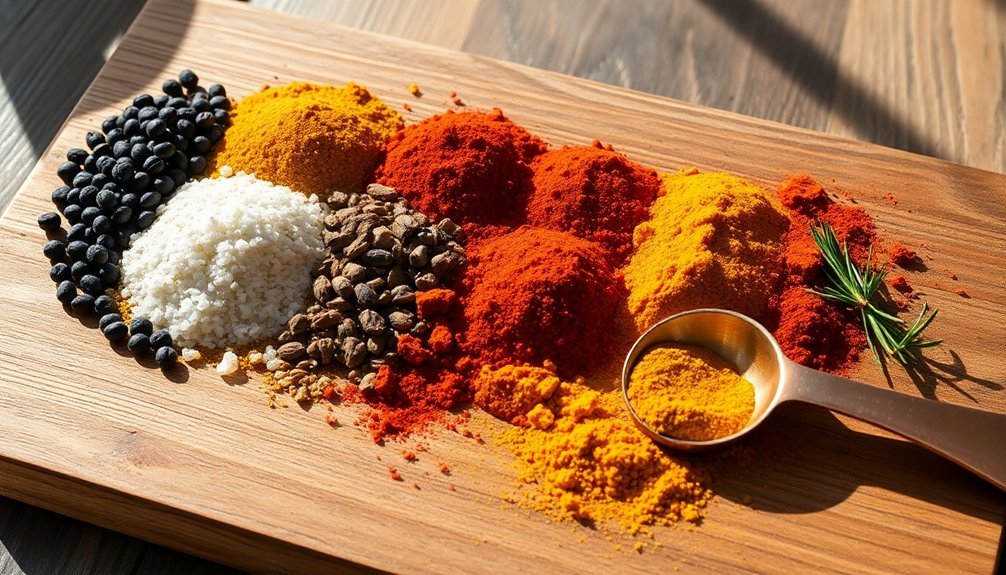
When creating spice rubs for solar-roasted meats, understanding the fundamental principles of flavor balance and heat management becomes essential.
You'll need to balance sweet elements like sugar with savory spices, while considering how the slower cooking time of solar roasting affects flavor development.
Start with a base of salt and sugar, then layer in complementary spices that you've toasted to enhance their natural oils and flavors.
Since solar cooking typically means longer exposure times, you'll want to avoid ingredients that might become bitter during extended heating.
Apply your rub evenly, using a thin coating of oil or mustard to help it adhere to the meat.
Remember that solar roasting's gentle heat allows spices to gradually release their flavors, creating a more nuanced taste profile.
For optimal results, use a dark-colored cast iron pot or pan to maximize heat absorption during the cooking process.
Mediterranean Sun-Dried Herb Blend
As Mediterranean cuisine draws heavily on sun-dried herbs and spices, this aromatic blend captures the essence of coastal flavors while perfectly complementing solar-roasted meats.
You'll need a base of garlic powder combined with classic Mediterranean dried herbs: oregano, basil, thyme, and rosemary. For added dimension, you can incorporate optional ingredients like dried dill, parsley, or sun-dried tomatoes. A pinch of smoked paprika or chili flakes will introduce a subtle heat. The blend's Italian oregano variety is particularly prized for its minty notes.
Mix your chosen ingredients in a small bowl, then transfer to an airtight container. If you prefer a finer texture, pulse the mixture in a spice grinder.
You'll find this versatile blend enhances everything from chicken thighs to grilled vegetables. For best results, use within a month and adjust the proportions to match your taste preferences.
Seven-Spice Middle Eastern Rub
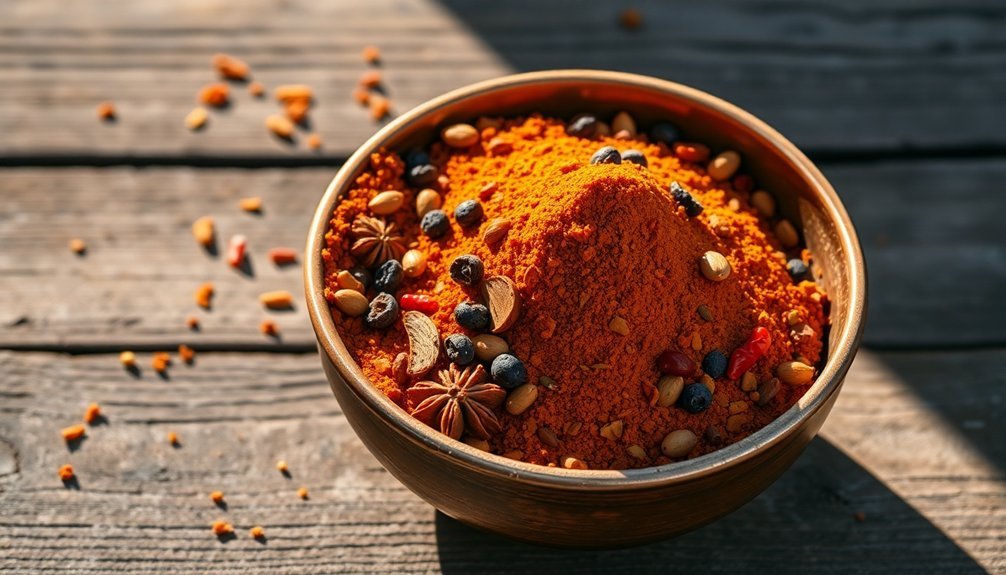
The rich culinary traditions of the Middle East come alive in this aromatic seven-spice blend, featuring warm notes of cinnamon, allspice, and cloves balanced with the earthiness of black pepper and nutmeg.
You'll get the best results by grinding whole spices in a mortar and pestle or spice grinder, though pre-ground spices work well too. Store your blend in an airtight glass jar for up to 3 months to maintain its potent flavors.
Don't skip the essential step of roasting your whole spices in a dry pan – it'll intensify their flavors considerably. Once you've combined your spices, sift them through a fine mesh sieve for uniform texture.
This versatile blend shines on grilled meats, but you can also use it to elevate soups, stews, and roasted vegetables.
Try sprinkling it over homemade burgers or using it as an alternative to za'atar on manakish.
Smoky Southwest Desert Seasonings
You'll find authentic Southwest flavor by combining earthy desert chiles like hatch peppers with classic herbs such as oregano and thyme.
Your rub can achieve a signature smoky profile through the careful addition of smoked paprika and mesquite-influenced seasonings. For optimal results, you can apply the seasoning mixture up to 24 hours before cooking to allow the flavors to fully penetrate your meat.
The heat level is yours to control, from mild to intense, by adjusting the ratio of chili powder and optional cayenne pepper in your blend.
Desert Chiles and Heat
When creating authentic Southwest desert spice rubs, chile peppers serve as the cornerstone of both flavor and heat. You'll find that traditional varieties like Pasilla, Guajillo, and Chimayo offer unique flavor profiles while contributing varying degrees of warmth.
Each chile brings its own character – from the sweet and fruity notes of habaneros to the smoky undertones of Red Fresno peppers.
You can control the heat level by understanding the Scoville scale. While jalapenos range from 3,500-11,000 SHU and serranos from 10,000-25,000 SHU, you might want to approach habaneros (100,000-200,000 SHU) and bhut jolokias (up to 1 million SHU) with caution.
For the best results, toast your chiles before blending them with complementary spices like coriander, cumin, and thyme to create a balanced, complex rub.
Southwest Herb Combinations
Creating authentic Southwest desert seasonings starts with mastering the perfect blend of herbs and spices that capture the region's bold, smoky essence.
You'll need ancho chili powder as your base, combined with earthy cumin and smoked paprika for that distinctive desert flavor profile.
Mix in garlic powder and dried oregano to build layers of savory depth, then enhance your blend with ground coriander's citrusy warmth and onion powder's subtle sweetness.
Don't forget to balance everything with kosher salt and black pepper. If you're craving heat, add cayenne to taste.
Store your mixture in an airtight container, and it'll stay fresh for up to six months. You can use it as a dry rub or create a marinade by mixing it with olive oil.
Try trusted brands like Morton & Bassett or Simple Organic for the best results.
Mesquite Flavor Profiles
Among Southwest desert seasonings, mesquite stands out as the king of smoke flavors.
You'll find it's the smokiest of all wood seasonings, delivering an intense, earthy profile that's perfect for robust meats. While it's primarily known for its bold smoky notes, you'll also discover subtle sweet and nutty undertones with hints of caramel.
When you're crafting your BBQ rub, use mesquite powder sparingly – just 1-2 tablespoons per 1-2 cups of mixture.
It works best with hearty cuts like beef brisket, lamb, and game meats, where its powerful flavor can truly shine. You'll want to avoid using it with delicate proteins like fish or chicken, as it can overwhelm their natural flavors.
For authentic Texas-style barbecue results, try combining it with smoked paprika, garlic powder, and onion powder.
Classic American Barbecue Blend
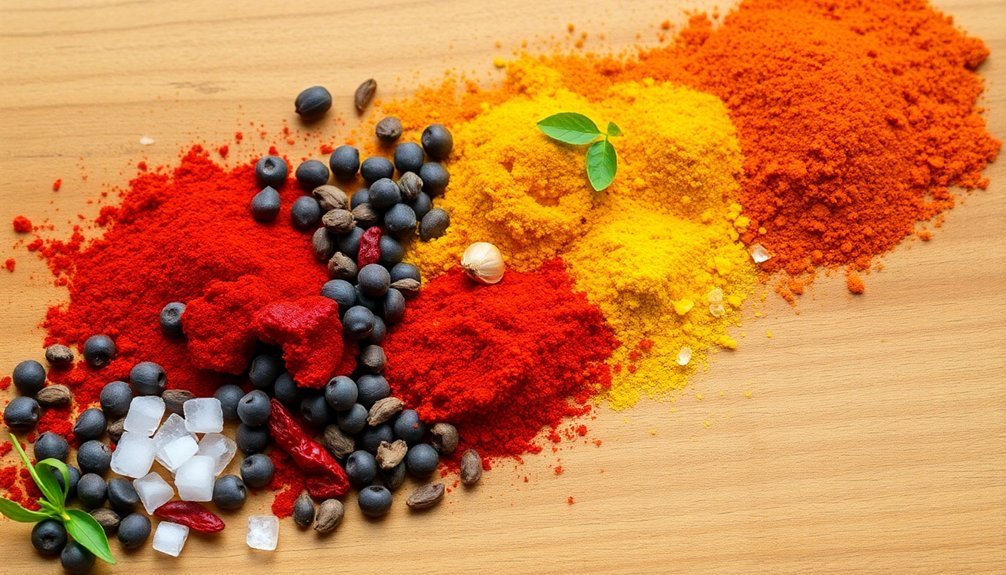
The heart of traditional American barbecue lies in its quintessential spice blend, which combines sweet, savory, and smoky elements into a harmonious mix. You'll want to start with a foundation of salt and both regular and brown sugars, then build layers of complexity with chili powder and black pepper.
| Region | Key Ingredients | Flavor Profile |
|---|---|---|
| Kansas City | Sugar, Smoked Paprika | Sweet & Smoky |
| Texas | Chili, Cumin, Garlic | Bold & Spicy |
| Southern | Cayenne, Black Pepper | Hot & Zesty |
| Memphis | Mustard, Paprika | Tangy & Rich |
For the best results, you'll need to apply your rub directly onto the meat. Consider using a thin layer of mustard or hot sauce first to help the spices stick. Let your seasoned meat rest for 30-60 minutes before cooking to allow the flavors to penetrate.
Aromatic North African Spices
You'll find Ras el Hanout's complexity remarkable, as this North African blend can contain anywhere from 12 to 100 spices, with cumin, turmeric, and coriander forming its aromatic base.
When creating your meat rub, start with small amounts and adjust to taste, since the intensity of these warm, sweet, and pungent flavors can overpower your dish.
While Berbere isn't listed in our traditional North African blends, it's worth noting that its fiery heat level from red chilies makes it a powerful alternative when you want to add both warmth and spiciness to your sun-roasted meats.
Ras El Hanout Basics
Originating from North Africa's rich culinary heritage, ras el hanout stands as one of the world's most complex and aromatic spice blends. Its name means "head of the shop," signifying the finest spices a merchant offers. You'll find this versatile blend enhances everything from meat rubs to vegetable dishes.
| Spice | Character | Best Uses |
|---|---|---|
| Coriander | Citrusy, Warm | Marinades, Rubs |
| Cumin | Earthy, Nutty | Stews, Meats |
| Cinnamon | Sweet, Woody | Tagines, Soups |
| Ginger | Spicy, Warming | Marinades, Fish |
| Nutmeg | Sweet, Aromatic | Lamb, Poultry |
To create your own blend, toast whole spices before grinding them to release their essential oils. Store your mixture in an airtight container, and it'll maintain its potency for up to six months. While commercial versions are available, homemade blends offer superior complexity and freshness.
Berbere Heat Intensity
While many spice blends offer complex flavors, berbere distinguishes itself with a carefully balanced heat profile that won't overwhelm your dishes. You'll find it delivers a medium to hot level of spiciness that's easily adjustable to your preferences.
If you're heat-sensitive, opt for milder versions using sweet paprika or Kashmiri chilies. For those craving more intensity, you can amp up the heat by adding extra chili peppers or incorporating mitmita, though berbere traditionally remains less fiery than its Ethiopian counterpart.
The blend's warmth comes from carefully toasted chilies combined with aromatic spices like cinnamon, nutmeg, and cardamom. When preparing your sun-roasted meats, you'll appreciate how berbere's versatile heat level complements rather than masks the natural flavors of your protein.
Asian-Inspired Solar Roasting Rub
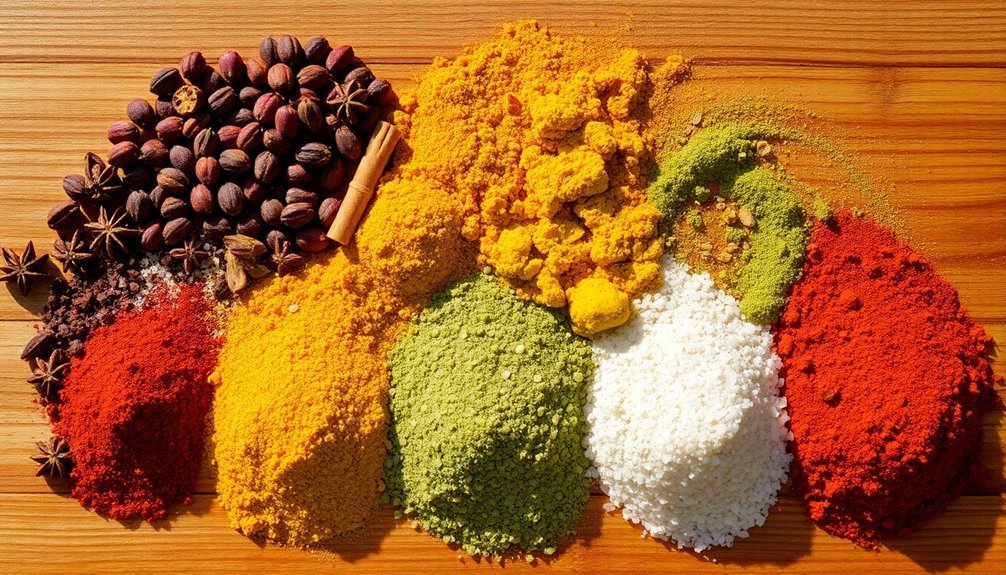
This Asian-inspired solar roasting rub combines traditional Eastern spices with modern cooking techniques to create a complex, aromatic blend perfect for sun-roasted meats.
Mix turbinado sugar, coarse salt, and black pepper with Chinese five-spice powder, then add crushed anise seed, garlic powder, ginger, Saigon cinnamon, and crushed red pepper for depth and heat.
For best results, preheat your solar oven to 325°F and use cast iron cookware for better heat retention.
Before solar roasting, brown your meat on the stovetop and add aromatic vegetables to enhance flavor.
You'll want to avoid aluminum foil, as it can reflect heat.
Apply the rub generously on all sides of your meat, then cook at 300-350°F until you reach your desired doneness.
Always let the meat rest before serving.
Frequently Asked Questions
Can I Reuse Leftover Spice Rubs That Haven't Touched Raw Meat?
Yes, you can safely reuse untouched spice rubs! Store them in an airtight container away from light and moisture. They'll stay flavorful for 8-10 months, and you can use them on various dishes.
How Long Do Homemade Spice Rubs Stay Fresh in Airtight Containers?
Your homemade spice rubs will stay fresh for up to 6 months in airtight containers when stored in a cool, dark place. You'll want to check them regularly, as their flavor and potency may gradually decrease.
Should I Oil the Meat Before Applying Dry Spice Rubs?
Yes, you should oil your meat before applying dry rubs. It'll help the spices stick better, prevent sticking while cooking, and enhance moisture retention. You can use olive oil or try alternatives like mustard.
Will Spice Rubs Burn in a Solar Oven's Intense Heat?
You don't need to worry about burning spice rubs in a solar oven. The gentle, evenly distributed heat (200-300°F) and slower cooking times actually help preserve your seasonings while preventing hot spots that could burn them.
Can I Substitute Dried Herbs for Fresh Ones in These Rubs?
Yes, you can substitute dried herbs for fresh ones in your rubs. Just remember to use 1/3 of the amount since dried herbs are more potent. For best results, avoid substituting dried parsley or basil.
In Summary
You'll find these seven sun-roasting spice blends transform ordinary meats into extraordinary meals. Whether you're craving Mediterranean herbs, Middle Eastern warmth, or Southwest heat, there's a perfect rub for your solar cooking adventure. Don't be afraid to experiment with different combinations and adjust the ratios to match your taste. Now get outside, harness that solar power, and start creating incredible flavors.

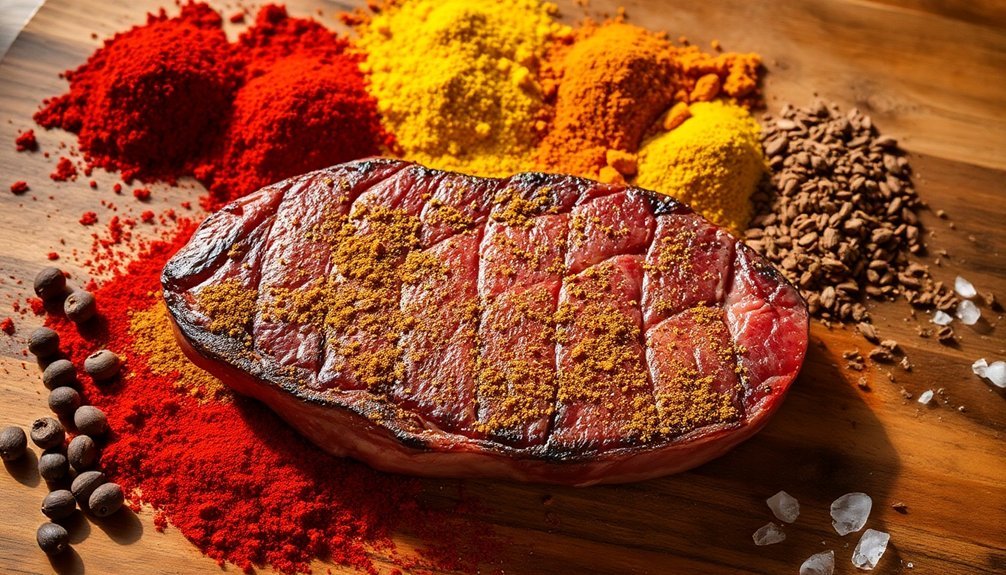



Leave a Reply